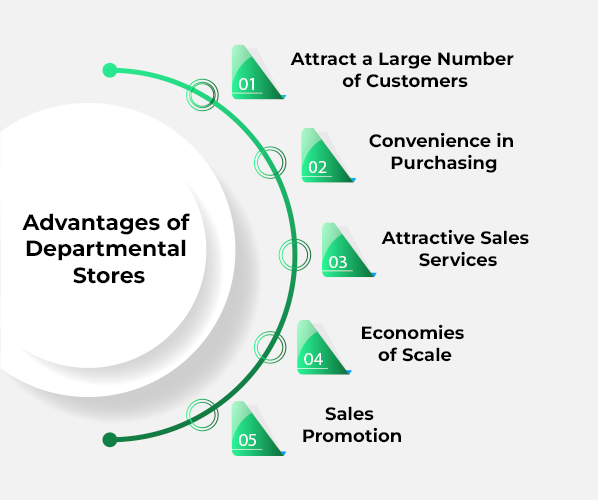Departmental Stores : Features, Advantages & Disadvantages
Last Updated :
07 Feb, 2024
What are Departmental Stores?
A department store is a large establishment that sells a wide range of products organised into distinct departments in order to satisfy nearly every customers’ requirements under one roof. It is divided into several departments, each of which focuses on a specific type of product. For Example: Within a store, there may be separate departments for toiletries, medicines, furniture, groceries, electronics, clothing, and dress material.

They cater to a wide range of market segments with a diverse range of goods and services. In the United States of America, it is not uncommon for a department store to sell ‘needle to an aeroplane’ or ‘all shopping under one roof.’ A typical department store’s spirit encompasses everything from “a pin to an elephant.” Real department stores have yet to make a significant impact in the retailing industry in India. However, in India, some stores carrying this line include ‘Akbarally’ in Mumbai and ‘Spencers’ in Chennai.
Features of Departmental Stores
The features of Departmental Stores are as follows:
1. Excellent Services: A modern department store may include all amenities such as a restaurant, a travel and information bureau, a phone booth, restrooms, and so on. As a result, they strive to provide the excellent service possible to a higher class of customers for whom price is secondary.
2. Centralised Locations: These stores are generally located in a central location in the heart of a city, where they can serve a large number of customers.
3. Corporate Status: As these stores are so large, they are usually organised as a joint stock company operated by a board of directors. A managing director is in charge, who is assisted by a general manager and several department heads.
4. Elimination of Middlemen: A department store performs both retailing and warehousing functions. They buy directly from manufacturers and have their own warehouses. As a result, they contribute to the elimination of undesirable middlemen between producers and customers.
5. Centralised Purchasing: They have centralised purchasing procedures. All purchases in a department store are made centrally by the store’s purchase department, whereas sales are decentralised in various departments.
6. Variety of Goods: These stores maintain a large variety of goods and services and are able to meet all the requirements of the customers.
Advantages of Departmental Stores
The advantages of Departmental Stores are as follows:

1. Attract a Large Number of Customers: As these stores are typically located in central locations, they attract a large number of customers during the busiest times of the day.
2. Convenience in Purchasing: By offering a wide range of goods under one roof, department stores allow customers to purchase almost all of their needs in one location. As a result, customers no longer have to rush from one location to another to finish their shopping.
3. Attractive Sales Services: A department store strives to provide the best services to its customers. Its services include home delivery of goods, telephone order execution, credit facility grant, and provision for restrooms, telephone booths, restaurants, salons, and so on.
4. Economies of Scale: Since these stores are organised on a large scale, they can utilize the advantages of large-scale operations, particularly in terms of purchasing goods.
5. Sales Promotion: Department stores can afford to spend a lot of money on advertising and other promotional activities that help them increase their sales.
Disadvantages of Departmental Stores
The disadvantages of Departmental Stores are as follows:
1. Lack of Personal Attention: Due to the large-scale operations, it is extremely difficult to provide adequate personal attention to customers in these stores.
2. High Operating Costs: As these stores place a higher emphasis on providing services, their operating costs tend to be higher. These costs, in turn, raise the prices of goods. They are not appealing to people with lower incomes.
3. High risk of Loss: Due to various high operating costs and large-scale operations, the risk of loss in a department store is high. For example, if customer tastes or current fashions change, it may be necessary to sell such out-of-date articles in a clearance sale to reduce the large inventory of goods built up.
4. Inconvenient Location: Because department stores are generally located in central locations, they are inconvenient for purchasing goods that are required quickly or for people who prefer to buy goods from nearer shops.
Despite some of these limitations, department stores have become popular in some Western countries due to the benefits provided to a specific class of customers.
Like Article
Suggest improvement
Share your thoughts in the comments
Please Login to comment...